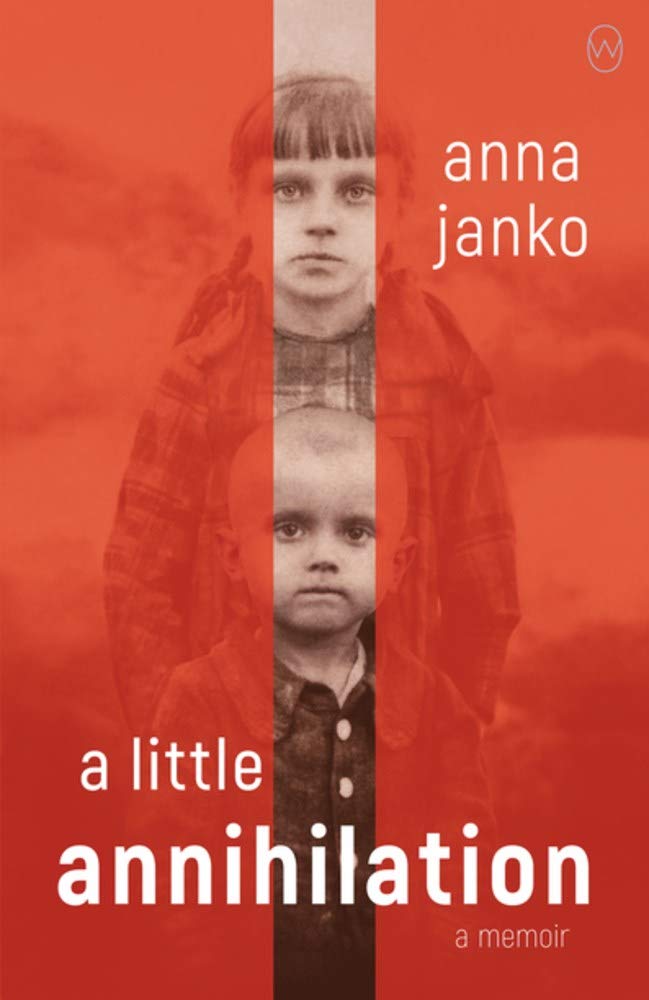
A Little Annihilation: A Memoir,
by Anna Janko. 2020
Reviewed by Jan Peczkis
Lasting Zamosc Trauma? Consider the fact that the Jews’ Holocaust has gotten mountains upon mountains of publicity, and so have the experiences of second-generation Holocaust survivors. Almost no one has heard the second-generation experiences of other genocides. This gem of a book is a significant exception to this Jewish near-total monopoly.
Author Anna Janko is the daughter of Teresa Ferenc, who was nine years old at the time of the German murder of many Polish villagers (including Ferenc’s parents) and the German burning of the Polish village of Sochy on June 1, 1943, as part of the Germans’ Aktion Zamosc. Janko provides general facts, reports on interviews with her mother, and then describes her second-generation traumatic experiences.
ANNA JANKO’S SECOND-GENERATION TRAUMA
Author Janko summarizes her experiences, “And me. I’ve taken your story, Mama, your apocalypse. You fed it to me when I was little, a tiny pinch at a time, so as not to poison me completely. But it added up. I have it in my blood. For decades it has darkened my image of the world. Today it may be more in me than in you.” (p. 211).
Here are some examples of Janko’s second-generation trauma:
“I fled German class after three lessons because I couldn’t stand the sound of that language. Whenever I heard it I felt anger and fear all at once.” (p. 151).
“…my constant perception that everything was transient, that nothing was guaranteed to last. Life without roots.” (pp. 151-152).
“I ate because later there may be hunger.” (p. 152).
“I wanted to have only girls because sons go to war. No, it’s better to have boys because girls get raped and killed.” (pp. 152-153).
“I would open the wardrobe and make an escape plan in case of emergency.” (p. 154).
“And what if I lose a child? What if someone snatches one away from me?” (p. 154).
NO JUSTICE FOR THE POLES. UNPUNISHED GERMAN CRIMINALS
Janko reminds us, “The murderers from Sochy were not punished, there was no redress…” (p. 53). She adds that, “The people from Sochy never cried out their hatred, they didn’t shed their fear, and they didn’t receive any satisfaction from justice being done, which in their case never happened.” (pp. 200-201).
—
OVERVIEW OF THE GERMANS’ ZAMOSC OPERATION
The German planning was as follows, “The plan to remove all the inhabitants of the Zamosc region and colonize it with German settlers was both inhumanely cruel and insanely simplistic. They planned to deport two hundred thousand people…young children were threatened with a ‘final solution’ like the one planned for the Jews.” (p. 44).
The author summarizes what happened, “In the Zamosc region alone, SS-men, soldiers, gendarmes, and police in service of the Germans pacified 115 villages, some of them several times; they ultimately deported 110,000 Poles (from nearly 300 villages). Of these 110,000, some 30,000 were children, of which 10,000 did not survive…These children died in Majdanek, or in Auschwitz, they suffocated in the freight cars during transport, they froze, they died of pneumonia. It’s unknown how many disappeared in Germany, where some arrived who had blue eyes…And if someone were to separately count the children killed on the spot, in the houses and courtyards?” (p. 48).
Janko adds that, “Those children from Soczy–both the ones killed and the ones who weren’t–were lucky. Because they didn’t wind up in the transit camps at Zwierzyniec and Zamosc, where there was horrible hunger, where lice and scabies devoured the children alive.” (p. 71).
In some respects, the living envied the dead. Janko comments, “Years later, I had a more precise picture: that after the pacification [of Soczy] children picked baked apples off the burned trees, that they ate sparrows, dogs, and cats.” (p. 150).
PLANNED LONG-TERM NAZI GERMAN EXTERMINATION OF THE POLES
Janko touches on the German genocidal ambitions against Poles, which were to improve upon what the Germans had done to the Jews. She writes, “Majdanek [Maidanek]: the crematorium ovens, manufactured by H. Kori GmbH, Berlin. Meanwhile, rival firm Topf applied to receive a patent for a multi-level oven designed to enable continuous cremation, where the bodies would be loaded onto a series of inclines that led to a central furnace at the bottom. I don’t know for whom they devised that idea, since by that time most of the Jews had already been incinerated. They even dug up and burned the ones who had been buried earlier…But of course they also had plans for the remaining millions of Slavs…” (p. 101).
POLISH VILLAGE LEADERS (SOLTYS) FORCED BY GERMANS TO REPORT ON POLISH GUERRILAS (AND FUGITIVE JEWS)
The following statements by the author show how closely the German authorities monitored the Polish villages, “In July of 1942. Himmler banned the word ‘partisan’ and introduced the term ‘bandit’…and declared a policy of collective responsibility…Every village leader had the responsibility of filing reports on partisan activity–or after the July decree, on ‘bandit’ activity–at the nearest police station.” (p. 55).
POLISH GUERRILLAS FIGHT BACK
Author Janko comments, “…the Roztocze forests were home to numerous and effective units of the Home Army [A. K., or Armia Krajowa] and the Peasant Battalions [BCh], who carried out various anti-German operations, including ambushes on German trucks, on transports of food and fuel, on trains carrying German settlers…Three days after Soczy was razed, the partisans retaliated by burning down a village of settlers, Siedliska.” (p. 131).
TO THE GERMANS: TAKE BACK YOUR CAMPS TO GERMANY!
Janko makes this trenchant comment, “In my opinion it would be best if Germany gathered up all the camps they left behind in Poland. So that no one would be mistaken any longer. So that Americans wouldn’t speak of ‘Polish death camps,’ because when that happens I get so angry I could transport the barracks myself.” (p. 96).

